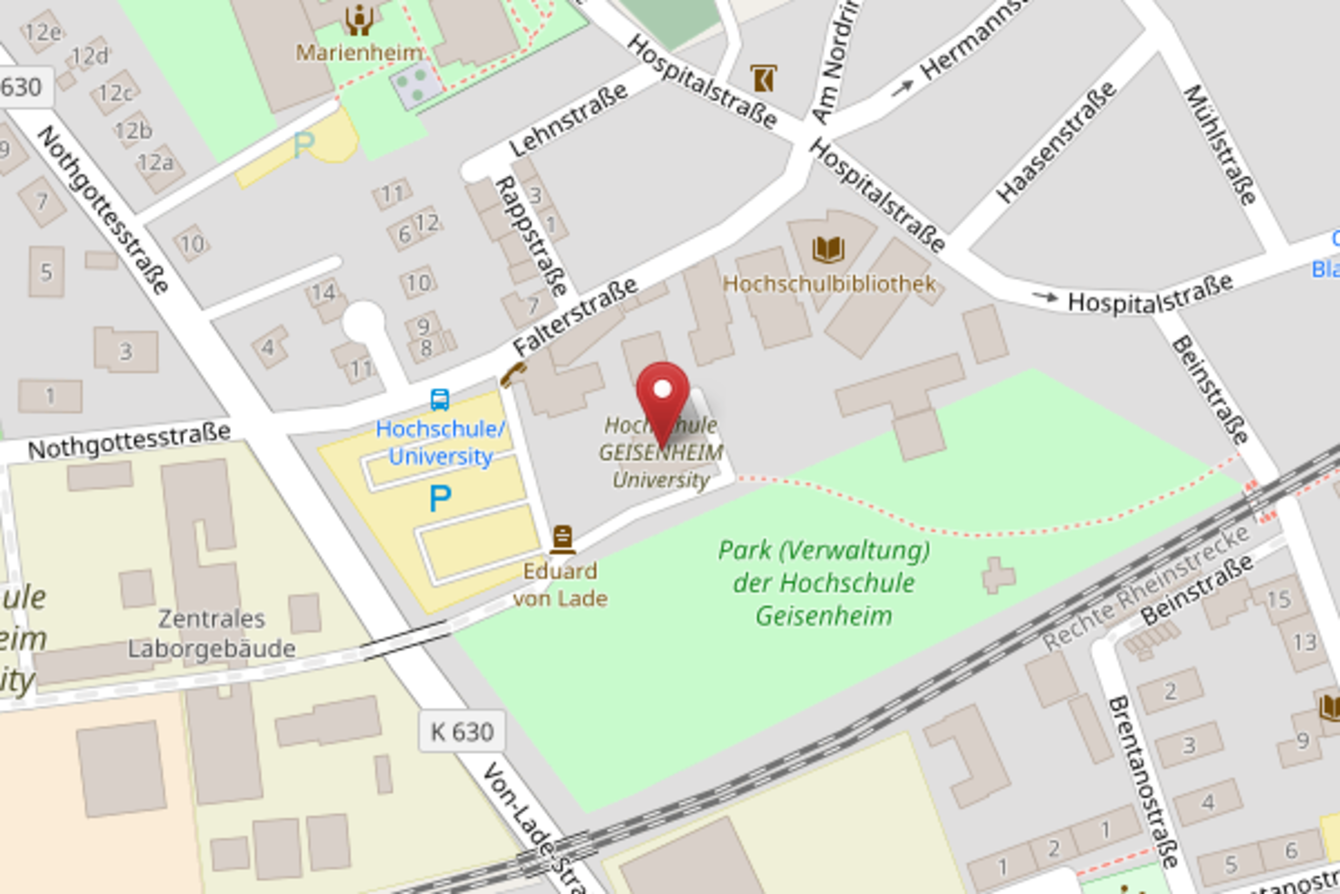Our Research Projects
Project start: 01.10.2019
Project end: 31.12.2024
Sponsor: German Research Foundation
In the course of this research project, an ultra-high performance liquid chromatography system interfaced with a high resolution QTOF coupled ion mobility mass spectrometer has been installed. Main tasks of the new system are the comprehensive characterization of technologically, nutritionally, and regulatorily relevant plant compounds, residues and contaminants in plant materials, foods and beverages as well as by-products of the food and agricultural industry.
Project start: 17.06.2019
Project end: 31.05.2024
Sponsor: Federal Ministry of Food and Agriculture
The control of downy mildew, caused by Plasmopara viticola, is one of the major challenges in viticulture,
especially in organic viticulture. Due to the ban of copper-containing pesticides and massive impacts of
climate change, organic viticulture is increasingly entering an economic crisis. Therefore, the aim of the
proposed joint project "VITIFIT" is to develop a catalogue of measures with practicable strategies for
maintaining grapevine health. In this way, cultivation conditions are improved, the production security is
consolidated and thus economic viability is guaranteed. Crop protection strategies will mainly be based on
copper minimisation (microencapsulated copper salts) and copper substitutes (plant extracts, UVC
technology) and their combination. Associated cultivation and cultural measures should reduce the
inoculum potential of P. viticola. Molecular biological analyses will address the mycobiome of the vine leaf
under these conditions. Particular attention should be paid to the plant protection agent potassium
phosphonate. Existing and newly bred fungus tolerant grape varieties (in German: PIWIs) should play a
central role in the developed action plans. Aims here are the improvement of the enological wine style, the
market acceptance of PIWIs and their introduction into practice. The identification of new resistance loci
against P. viticola and their integration into current breeding lines will support the development of novel
PIWIs. Another focus of the project is the adaptation of the forecast model "VitiMeteo Rebenperonospora"
to PIWIs. In the sector of knowledge and technology transfer, communication, the flow of information and
networking between research and practice are to be optimised. The VITIFIT project should make a
significant contribution to achieving the "20% goal" (national sustainability goal concerning the percentage
of organic agriculture area).
Project start: 01.07.2021
Project end: 31.12.2023
Sponsor: Alexander v. Humboldt Stiftung
This project is being carried out within the framework of a Georg Forster Fellowship funded by the Alexander von Humboldt Foundation. The aim of the research project is to apply quantitative 1H-NMR spectroscopy to the analysis of tropical fruits and products derived thereof. The focus is on fruits of commercial importance for Costa Rica, such as pineapple and papaya. Furthermore, hitherto little-used fruits such as the red-fleshed dragon fruit, guanabana, mangosteen and star fruit are being investigated. In particular, the influence of different processing conditions on nutritionally relevant ingredients is to be analysed, utilizing the oxygen-excluding novel spiral filter press.
Project start: 01.12.2020
Project end: 31.05.2023
Sponsor: Federal Ministry for Economic Affairs and Energy
Stirred fruit yogurt is the most widely consumed dairy mix product in Germany and contains up to 17% sugar, of which 4-6% is the sugar lactose from milk. Previous research approaches pursued the possibility of reducing sugar by increasing the sweetness of naturally present sugars by using bi-enzymatic processes. As a result, for instance, the sweeter monosaccharides glucose and galactose were formed from the comparably poorly sweet disaccharide lactose and, thus, less sugar had to be added by recipe to achieve the same sweetness. Our new research approach now involves reducing the added sugar (fruit preparation, priority 1) as well as the naturally present lactose (yogurt, priority 2) and fructose (fruit puree, priority 3). The aim of the project is to develop practical, food-technological principles for the production of sufficiently sweet fruit yogurts with high sensory quality and acceptance and a reduced total sugar content from an average of 15 g/100 g to 6-9 g/100 g (corresponding to a reduction of 40-60 %).
Project start: 06.01.2020
Project end: 30.06.2022
Sponsor: German Federation of Industrial Research Associations
The formation of haze in wine and sparkling wine is a major problem of the beverage industry. Due to the climate change and warmer vintages since 1990, the prevalence of haze formation in German wines has increased. Increased protein contents of musts and wines are triggered by drought stress and fungal infections. This causes a higher demand for bentonite as clarification and finishing agent and comes along with losses of wine. Apart from that, quality determining constituents, mainly anthocyanins in red and rosé wines and aroma compounds in white wine may be lost by adsorption to the bentonite. Especially wines from steep slope viticul-ture in Germany are affected by reduced sensory quality caused by high bentonite dosages. Currently, no efficient alternatives to bentonite finishing for removal of haze forming proteins from wine are available. The enzymatic degradation of the protein fraction of wine via commercial peptidases was not successful, which indi-cated unusual stable tertiary structures of wine proteins.
The aim of the current research project is to characterize haze forming wine proteins and to develop an efficient enzymatic process to avoid haze formation in wine. The specific degradation of haze causing proteins via novel peptidases (proteases) as alternative to bentonite will be examined. Therefore, a comprehensive screening of peptidases from insects will be performed. Based on successful preliminary studies, research will focus on those insects that feed on grapes (e.g. Drosophila suzukii). A combined method of enzymatic protein degradation with bentonite finishing will be investigated to lower the bentonite consumption. The products of the enzymatic hy-drolysis (peptides and amino acids) will be characterized analytically and their po-tential influence on the sensory properties of wine will be investigated. The stability of peptidase treated musts and wines will be determined in storage trials.
Project start: 01.01.2020
Project end: 30.06.2022
Sponsor: Forschungskreis der Ernährungsindustrie e.V.
A health-conscious diet containing beneficial plant compounds continues to be very popular with consumers. Fruit juices provide health-relevant ingredients such as vitamins, minerals and secondary plant substances. In addition to positive nutritional effects, certain bioactive plant substances (polyphenols) from fruits and juice (e.g. cranberry, apple, grape) have also shown caries-protective effects in previous studies (inhibition of caries bacteria, biofilm formation, pH drop, enzyme activity of amylase and glucosyltransferase). However, these effects have not been sufficiently demonstrated by in vivo studies, yet. Particularly human intervention studies are lacking.
Since caries is still a widespread disease in all age groups and juice, due to its sugar content, poses a risk for the development of caries, a polyphenol-rich juice with caries-inhibiting effects would strengthen the healthy characteristics of juice. In addition, the results will provide a counterbalance to the sugar debate that is currently weighing on the fruit juice industry.
In conventional juice production, the polyphenol concentration in the juice is relatively low because a large proportion of the polyphenols remain in the pomace or low-polyphenol raw materials are used. Production techniques that can be used to increase the natural polyphenol content in the juice and polyphenol-rich raw materials offer the possibility of developing juices with caries-inhibiting properties. Since juices with high polyphenol concentrations can lead to a bitter and astringent taste and usually also correlate with a high acid content, these factors must also be taken into account.
The aim of the project is to produce a juice mixture using different polyphenolic fruits with different polyphenol profiles (apple, quince, speierling (Sorbus domestica)), which has both optimal caries inhibiting effects and good sensory properties.
Project start: 11.11.2019
Project end: 06.05.2022
Sponsor: Federal Office for Agriculture and Food
The project aims at producing, analyzing and applying novel formulations from stilbenoid-rich extracts of the viticultural by-product grape cane. Scientific goals include the in-depth investigation of biological (e.g., cultivar, vintage, location, weather conditions) and technological (e.g., storage, extraction methods) impacts upon the stilbenoid levels of grape cane extracts as well as the decipherment of further phenolic compounds herein. In order to stabilize these UV-sensetive bioactive substances, a special focus is furthermore laid on the optimization of the extract formulation. In a last step, grape cane extracts are tested on their fungicidal efficacy against downy mildew (causal agent: Plasmopara viticola) in laboratory, greenhouse and field trials.
Project start: 01.03.2020
Project end: 01.03.2022
Sponsor: European Commission, Federal Ministry of Education and Research
OPTIBERRY targets innovative processing and biorefinery/extraction concepts to food prototypes and (non)-food ingredients for sustainable use of berry biomass available, especially the non-premium fruit. The project will result high added value (non)-food applications to process or market the non-premium class fruit of raspberry, strawberry and blackberry (Figure 1). This valorisation will result in a more resilient berry supply chain, creating a secure and long-lasting sustainable relationship between the berry grower and its potential customers.
Berries were chosen for their economic importance and local clustered availability. In Europe almost 2 million tons of berries are grown.However, more than 15% of these berries do not enter the fresh market because of quality reasons. Part of these non-premium fruit finds a destination in the industry but are sold at dumping prices.
Economically relevant functionalities and bio-activities have been assigned to berry biomass. Most of the berry species are rich in broad set of functional molecules such as polyphenols. This provides multiple opportunities for the envisaged bio-based product development.
Project start: 01.03.2016
Project end: 29.02.2020
Sponsor: European Commission
Coordinated by the University of Málaga, GoodBerry is
focusing on strawberry, raspberry and black currant as model crop species and
will study among others the adaptability of
cultivars to different climatic conditions and the impact of these conditions
on fruit quality. Global warming influences induction and initiation of flowers
and the fulfillment of chilling requirement of the plants. First impairments
were already observed in strawberries and currants under German growing
conditions in the last decade. By cultivating well established cultivars of the
three species with varying adaption to diverse environments at different
locations within Europe the project design simulates the influence of climate
change on berry cultivation. GoodBerry will build on novel molecular tools to apply
cutting-edge genomic and metabolomics based approaches to deliver holistic
solutions addressing the challenges of increasing productivity efficiency, crop
resilience and food quality in the light of climate changes.
Project start: 01.05.2011
Project end: 31.10.2014
Sponsor: European Commission
Beside the traditional cultivation of raspberry in open field, they are now increasingly grown under rain protection or in high tunnels to extend the cropping period. The main used plastics are standard polyethylene foils to cover rainshelters and tunnels. However, different materials are available nowadays which vary in their transparency for UV radiation or have shading properties. Raspberry leaves and berries are rich in in vitamin C and polyphenols. They are synthesized at biotic or abiotic stress and their antioxidant action protect the plants against oxidative stress by free radicals. Moreover, these bioactive compounds play a crucial role in the prevention of a wide range of human diseases.
The use of high tunnels alters the growing conditions for raspberries by changes of the microenvironment, mainly temperature. Photosynthesis is one of the most temperature-sensitive factors controlling plant growth. Beside photosynthesis, heat stress is negatively associated with a lot of physiological activities. However, less is known about changes of photosynthesis, carbohydrate synthesis and accumulation of nutritional ingredients in raspberry fruits grown under plastic tunnels.
Therefore, the impact of different environments (light intensity and – quality, temperature and rel. humidity) on photosynthesis of raspberry plants and their carbohydrate and polyphenol compounds will be studied in a comparative trial between cultivating them in open field or in high tunnel with shading or different UV transparency properties.


